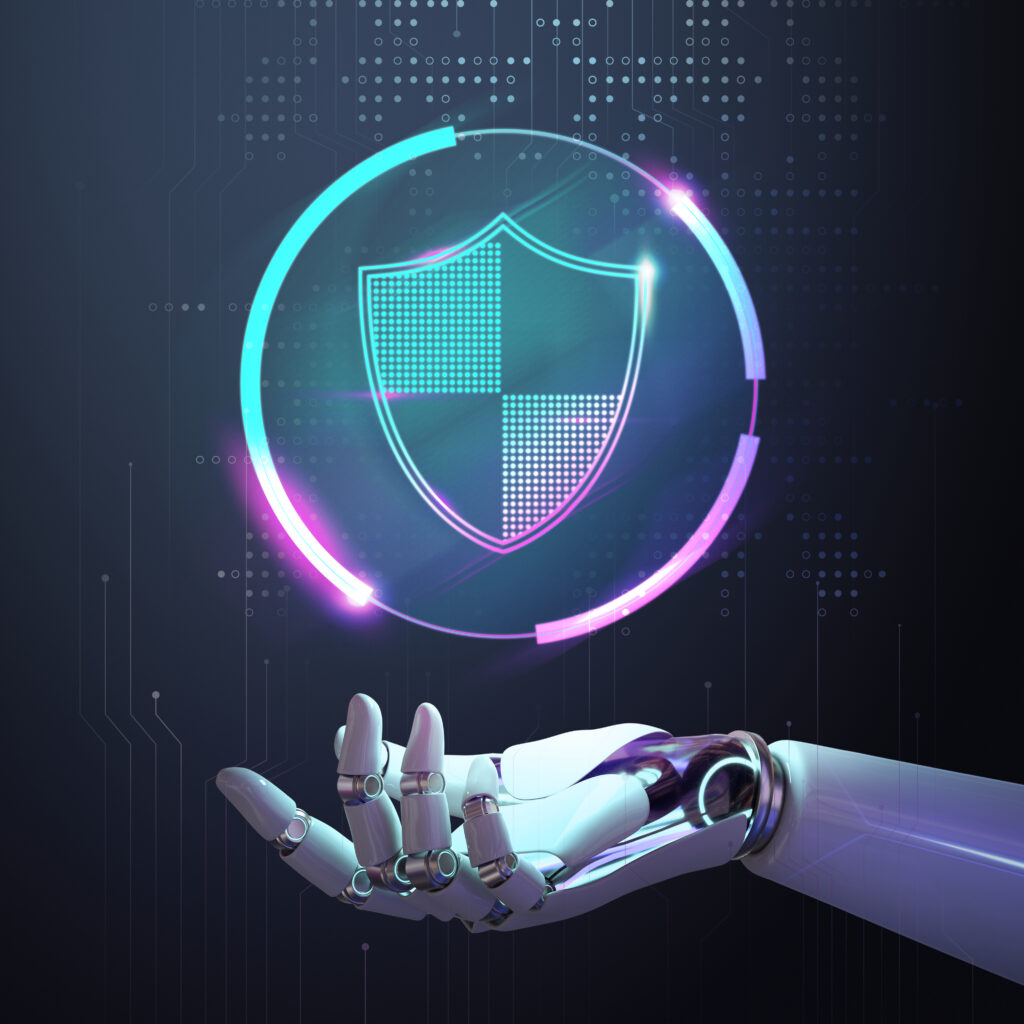Introduction
Cybersecurity is evolving—and so are the threats. As organizations digitalize operations, attackers are leveraging sophisticated tools and techniques. Defending today’s complex IT environments with traditional security measures alone is no longer enough. Enter Artificial Intelligence (AI)—a powerful enabler in transforming cyber defense.
AI in cybersecurity combines machine learning, behavioral analytics, and automation to detect, predict, and respond to cyber threats in real time. It doesn’t replace human judgment, but augments security operations by rapidly identifying patterns and anomalies that would take human analysts days to uncover. This hybrid approach—human + AI—is redefining what’s possible in cyber defense.
For IT leaders and executives, understanding how AI can enhance your cybersecurity strategy is not a future consideration—it’s a present imperative. From faster detection to predictive intelligence and automated response, this guide explores how AI is not just improving cybersecurity—it’s becoming essential to it.
Cybersecurity in Banking
AI in the banking sector enables intelligent fraud detection, risk-based authentication, and anomaly detection in digital transactions. Its ability to process massive volumes of data ensures real-time protection for financial institutions against sophisticated threats.
Understanding AI for Cybersecurity
AI for cybersecurity refers to the use of artificial intelligence and machine learning algorithms to identify threats, respond to attacks, and automate security tasks. It enables proactive and scalable protection across endpoints, networks, and cloud systems.
- Uses ML to analyze vast security datasets
- Identifies anomalies in real time
- Supports threat detection and mitigation
- Reduces false positives in alerts
- Enables predictive security insights
- Automates repetitive monitoring tasks
- Enhances human decision-making
- Integrates with SOC tools and SIEM platforms
Role of AI in Cyber Security
AI plays a central role in modern cybersecurity by acting as an intelligent assistant to security teams. It detects, prevents, and responds to cyber threats faster than traditional methods, minimizing damage and downtime.
- Speeds up threat detection and response
- Identifies hidden and evolving threats
- Automates malware classification and triage
- Enables adaptive security across environments
- Detects insider threats through behavior analysis
- Prioritizes vulnerabilities using contextual data
- Reduces noise in Security Operations Centers (SOCs)
- Facilitates compliance through intelligent reporting
Role of Business Analyst in Cyber Security
Business analysts bridge the gap between security teams and business units by translating complex technical risks into business impact. They help define security requirements, analyze gaps, and align cybersecurity business analyst strategies with organizational goals.
AI for Cybersecurity Use Cases
AI is being applied across numerous cybersecurity use cases—from endpoint detection to cloud threat analytics. It improves efficiency, accuracy, and responsiveness of security measures at scale.
- Email phishing detection and prevention
- Behavioral analytics for user and entity behavior
- Automated incident response and triage
- Vulnerability management prioritization
- Real-time network traffic anomaly detection
- Identity and access behavior monitoring
- Fraud detection in banking and e-commerce
- Threat intelligence correlation across tools
How Can AI Help Prevent Cyberattacks?
AI helps prevent cyberattacks by identifying abnormal patterns, flagging suspicious activity early, and automating responses to threats. Its predictive capabilities allow organizations to stay ahead of attackers.
- Analyzes logs to uncover intrusion patterns
- Detects zero-day threats using behavioral indicators
- Alerts on account compromise or data exfiltration
- Flags brute-force and DDoS attempts in real time
- Enhances threat hunting with ML-based analysis
- Blocks suspicious email or domain activity
- Integrates seamlessly with firewall and endpoint tools
- Triggers immediate isolation of affected systems
Is it Safe to Automate Cybersecurity?
Yes—when done with oversight. Automation enhances speed and reduces human error in response, but human judgment is still vital. Combining AI-powered automation with human control delivers robust, adaptive cybersecurity.
- Automates patching and software updates
- Responds instantly to known threats
- Streamlines alert triaging and classification
- Reduces response time from hours to seconds
- Improves SOC efficiency and coverage
- Maintains oversight for critical decisions
- Prevents fatigue in security teams
- Allows redirection to strategic security work
Applications of AI in Cybersecurity
AI’s applications in cybersecurity are broad—ranging from data classification to real-time risk scoring. These tools improve situational awareness and accelerate incident response.
- Automated log analysis and pattern recognition
- Real-time anomaly detection in traffic
- Advanced malware analysis and sandboxing
- Botnet activity identification and mitigation
- Risk scoring for endpoints and users
- Predictive analytics for breach likelihood
- Secure access management using AI
- Early warning for insider threats
Top AI-Powered Cybersecurity Tools
Leading cybersecurity for business platforms now embed AI into their core. These tools enhance visibility, reduce response time, and adapt to changing threat landscapes.
- Darktrace for AI-based threat detection
- CrowdStrike Falcon for endpoint protection
- IBM QRadar with cognitive SIEM features
- Vectra AI for network behavior analytics
- Microsoft Defender with AI and automation
- Cynet for autonomous breach protection
- Exabeam for user behavior analytics
- Google Chronicle for security data lakes
How Can Generative AI Be Used in Cybersecurity?
Generative AI, like large language models (LLMs), enhances cybersecurity operations through intelligent content generation, knowledge base automation, and advanced simulation capabilities.
- Generates threat intel summaries from raw data
- Automates policy and report documentation
- Supports phishing simulation creation
- Assists with SOC alert contextualization
- Improves employee training using AI tutors
- Creates test cases for secure development
- Builds response playbooks using natural language
- Enables adversarial simulation models (red teaming)
Benefits of Artificial Intelligence (AI) in Managing Cyber Risks
AI significantly strengthens risk posture by accelerating threat detection, reducing alert fatigue, and enabling proactive threat management at scale.
- Detects threats before they become incidents
- Increases accuracy in identifying real alerts
- Automates low-risk tasks and patching
- Scales security operations without extra headcount
- Helps meet regulatory mandates with audit trails
- Supports strategic decision-making via dashboards
- Improves uptime by minimizing response delay
- Enables faster recovery from breaches
The Future of Cybersecurity: How AI is Shaping a Safer Tomorrow?
AI is transitioning cybersecurity from reactive defense to predictive resilience. Its future includes autonomous threat management, continuous learning, and AI-on-AI countermeasures.
- Adaptive AI will evolve with attacker techniques
- Autonomous agents will handle real-time response
- Generative AI will assist with threat modeling
- AI ethics frameworks will guide security boundaries
- AI-driven identity access will reduce fraud
- Proactive defense will replace reactive triage
- Human-AI collaboration will drive faster insights
- AI will fuse physical and digital security operations
Challenges in Cyber Security for Business
AI integration faces several roadblocks, especially in business environments where balancing security, scalability, and cost is critical.
- Data silos across departments
- Poor alignment between security and business goals
- Limited cybersecurity awareness among decision-makers
- High initial investment in AI infrastructure
- Lack of clear ROI measurement
- Concerns about data sovereignty
- Skills gap in AI and cybersecurity combined domains
Challenges in Implementing AI for Cybersecurity in Banking
Despite its potential, implementing AI in banking cybersecurity poses challenges around ethics, data privacy, bias in algorithms, explainability, and integration with legacy systems. A cautious and compliant approach is key.
- Regulatory hurdles on AI usage
- Risk of over-reliance on automation
- Inadequate data quality or volume
- Challenges in model transparency
- Threat of AI model poisoning
- Lack of skilled AI-security professionals
- Complexity in hybrid infrastructure
- Cost of AI implementation at scale
AI in Managed Detection and Response (MDR)
AI improves MDR by continuously monitoring, detecting, and responding to cyber threats—delivering rapid protection to SMEs and large enterprises alike.
- Detect threats across endpoints, cloud, and network
- Automate response and containment workflows
- Reduce SOC alert fatigue
- Improve threat prioritization with AI scoring
- Support 24/7 detection coverage
- Lower mean time to resolution
- Provide contextual alerts for SOC analysts
- Enhance threat hunting with machine learning
AI-Augmented Vulnerability Management for IT Providers
AI helps identify and prioritize vulnerabilities based on real-world exploitability and business impact, enabling smarter patching strategies.
- Scan environments for critical vulnerabilities
- Use threat intelligence for prioritization
- Predict potential exploit pathways
- Automate patch deployment workflows
- Reduce patching time and effort
- Track remediation progress in dashboards
- Identify legacy system risks
- Schedule updates based on impact models
AI for Identity and Access Management (IAM)
AI-powered IAM systems improve authentication, detect suspicious access, and reduce insider threat risks by analyzing behavior patterns.
- Enable adaptive authentication methods
- Detect anomalies in login patterns
- Auto-flag risky privilege escalations
- Learn from user behavior baselines
- Prevent credential stuffing and brute force
- Manage just-in-time access requests
- Integrate biometric authentication with AI
- Alert on dormant accounts activity
Using AI to Enhance Cybersecurity Awareness Training
AI customizes security training by analyzing employee behavior and tailoring educational content to address specific gaps or risk behaviors.
- Track phishing simulation outcomes
- Personalize awareness modules
- Monitor policy acknowledgment and comprehension
- Score departments by cyber risk behavior
- Automate reminders for critical training
- Analyze knowledge retention with quizzes
- Identify high-risk users or roles
- Reinforce learning with AI-powered nudges
For AI in Cybersecurity, Choose Infodot
Infodot brings AI-enabled cybersecurity solutions tailored for modern enterprises. We help organizations deploy scalable, ethical, and intelligent defense frameworks—powered by expert human oversight and 24/7 managed services.
- Deploy AI for threat detection and response
- Integrate AI with existing security architecture
- Offer predictive insights from real-time telemetry
- Provide compliance-aligned security automation
- Reduce false positives through intelligent filtering
- Deliver scalable threat intelligence
- Support ethical and transparent AI governance
- Enable proactive security risk reduction
Real-World Examples
Real-World Example 1: AI Stops Ransomware in Mid-Sized Manufacturer
A mid-sized manufacturing firm experienced multiple phishing attempts targeting staff accounts. Partnering with an AI-based MDR provider, they deployed behavioral analytics to monitor endpoints and user activity. Within days, the system detected unusual encryption activity at 2 a.m., indicating ransomware execution.
The AI system automatically isolated the affected machine, terminated the process, and alerted IT. A detailed report enabled forensic analysis, confirming an attempted attack via a compromised email attachment.
Outcome: Business operations were uninterrupted, and no data was lost—thanks to AI’s early anomaly detection.
Real-World Example 2: Financial Firm Uses Generative AI for Playbooks
A global financial firm with multiple data centers faced delays in their cyber incident response process. They integrated a generative AI tool to build dynamic, scenario-based playbooks that adapted based on the type of breach.
The AI analyzed past incident logs and regulatory requirements to generate actionable step-by-step responses. It also created executive summaries and post-incident reports in real-time.
Outcome: Response time improved by 40%, audit reporting became faster, and the SOC team focused more on proactive threat hunting.
Conclusion
AI is rapidly transforming cybersecurity, not just by automating tasks but by augmenting decision-making, enhancing threat visibility, and reducing risk exposure. As cyber threats grow more advanced and business infrastructure becomes increasingly complex, AI provides the scale, speed, and adaptability needed to stay ahead.
But AI is not a silver bullet. It must be implemented thoughtfully—guided by ethics, transparency, and aligned with your business needs. Organizations must combine machine learning with human judgment, strong governance, and managed service support to maximize its benefits.
At Infodot, we help organizations embed AI into their cybersecurity strategies—responsibly and effectively. Our consultative approach ensures that AI solutions work for you, not just with you. In an era where milliseconds matter, it’s not just about defending against attacks—it’s about anticipating them. That’s the future of cybersecurity with AI. Let’s build it—securely, together.
Related 30 FAQs
How is AI used in cybersecurity?
AI is used to detect anomalies, identify threats, automate response, predict attacks, and reduce false positives—enhancing real-time protection across networks, endpoints, and cloud systems.
Is AI a benefit or threat to cybersecurity?
AI is both. It enhances cybersecurity defenses but can also be weaponized by attackers. Proper governance ensures it’s used ethically and securely for defensive strategies.
How can generative AI be used in cybersecurity?
Generative AI creates synthetic data, simulates attack vectors, writes playbooks, and automates incident responses—but needs safeguards to avoid abuse by malicious actors.
What are the key use cases for AI in cybersecurity?
Key use cases include threat detection, behavioral analytics, phishing prevention, vulnerability prioritization, and incident response automation.
What are best practices for AI in cybersecurity?
Use explainable models, monitor outputs, train with diverse data, apply continuous learning, and implement strong access controls to prevent misuse.
How can organizations ensure AI ethics in cybersecurity?
They should ensure transparency, avoid bias, use diverse datasets, monitor AI actions, and align tools with legal and ethical guidelines.
Is AI replacing cybersecurity professionals?
No, AI supports professionals by automating repetitive tasks, but human oversight, critical thinking, and decision-making remain essential.
Can AI stop phishing attacks?
Yes, AI can analyze emails, detect spoofed domains, and flag suspicious behavior to prevent phishing attempts before users are compromised.
What is machine learning in cybersecurity?
Machine learning enables systems to learn from past incidents and adapt defenses, improving detection of previously unknown or evolving threats.
How does AI help in fraud detection?
AI monitors transaction patterns, flags anomalies in real-time, and blocks suspicious activities to prevent financial fraud in banking and ecommerce.
What industries use AI in cybersecurity?
All major industries—banking, healthcare, manufacturing, retail, and government—use AI to protect data, systems, and infrastructure.
Are AI-driven firewalls more effective?
Yes, they can adapt to new attack patterns, self-tune rules, and detect threats that traditional firewalls may miss.
What is behavioral analytics in AI cybersecurity?
It involves AI studying user or device behavior to detect unusual actions, indicating potential insider threats or compromised systems.
What’s the role of AI in SIEM?
AI enhances SIEM by correlating alerts, prioritizing incidents, and reducing noise—enabling faster, more accurate threat analysis.
How does AI help small businesses in cybersecurity?
AI tools offer scalable, automated protection without the need for large in-house security teams—making enterprise-grade defense accessible to SMEs.
Can AI predict cyberattacks?
AI can forecast potential attack patterns using historical data and threat intelligence—offering preemptive defense before an attack materializes.
What is the role of AI in MDR?
AI powers continuous monitoring, rapid threat identification, and automated containment—enhancing the effectiveness of Managed Detection and Response services.
Can AI reduce response time in cyber incidents?
Yes, AI automates detection and initial response, allowing incidents to be addressed in seconds instead of hours or days.
Does AI help in vulnerability management?
AI can prioritize vulnerabilities by exploitability, impact, and threat intelligence—helping teams patch the most critical issues first.
What is adversarial AI in cybersecurity?
It refers to attackers manipulating AI models or feeding false data to bypass defenses or corrupt automated systems.
Is AI in cybersecurity expensive?
Initial investment can be high, but AI reduces long-term costs by minimizing breaches, automating tasks, and increasing efficiency.
What is AI model poisoning?
Model poisoning is when attackers inject malicious data into training sets, corrupting AI systems to misclassify or ignore threats.
How does AI help in identity and access management?
AI monitors login behaviors, flags anomalies, and enforces adaptive access controls to reduce identity-related security risks.
Can AI be used in SOC operations?
Yes, AI helps Security Operations Centers by analyzing large datasets, prioritizing alerts, and generating actionable insights in real-time.
What skills are needed to manage AI cybersecurity tools?
Skills include data science, threat analysis, scripting, model tuning, ethical AI use, and knowledge of cybersecurity frameworks.
What are the limitations of AI in cybersecurity?
AI can be biased, lacks context awareness, and may produce false positives or negatives if not trained properly or monitored.
How do AI chatbots enhance cybersecurity?
Security chatbots can provide users with instant support, flag phishing attempts, and help with incident reporting in real-time.
Can AI support compliance in cybersecurity?
Yes, AI automates audit trails, ensures policy enforcement, and helps monitor controls for regulations like GDPR, HIPAA, and ISO 27001.
What is Explainable AI (XAI) in cybersecurity?
XAI ensures that AI decisions are understandable, traceable, and auditable—important for trust and compliance in critical environments.
Why should organizations adopt AI for cybersecurity now?
Cyber threats are faster and more complex. AI provides the speed, scale, and intelligence needed to defend against today’s evolving digital risks.




